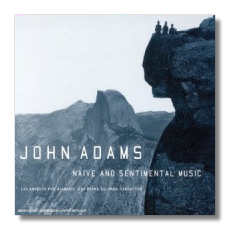
The Internet's Premier Classical Music Source
Related Links
- Adams Reviews
- Latest Reviews
- More Reviews
-
By Composer
-
Collections
DVD & Blu-ray
Books
Concert Reviews
Articles/Interviews
Software
Audio
Search Amazon
Recommended Links
Site News
 CD Review
CD Review
John Adams

Naïve and Sentimental Music
Los Angeles Philharmonic Orchestra/Esa-Pekka Salonen
Nonesuch 79636-2 DDD 44:22
John Adams completed Naïve and Sentimental Music in 1999, and it was premièred by Esa-Pekka Salonen and the Los Angeles Philharmonic later that year. (This recording was made in October 1999, and I have no idea why Nonesuch has been hanging onto it for so long, as they are wont to do.)
This work feels like a homecoming in several ways. First, for the past decade or so, Adams has shied away from the proverbial Large Orchestral Statement, which this certainly is. Oh yes, he's written theater pieces and concertos and an oratorio, but one has to look back to Harmonielehre to find the precedent of Naïve and Sentimental Music. One might say that the latter work is the former's child, sent out in the world to gain experience before returning home. Structurally, there are similarities between the two. For example, both are in three movements, with a slow, elegiac middle movement framed by a long, accelerating first movement, and by a shorter, driving third movement. In terms of style, there are more echoes of the Harmonielehre -era Adams in this new work than in any other work of his that I've heard in the last fifteen years. (Naïve and Sentimental Music is thicker, more dissonant in its climaxes than the earlier work, however.) Also fellow composer Ingram Marshall has described the first movement (an "essay on melody," according to Adams) as "a journey (without a destination – the trip's the thing)." In turn, the third movement is, according to Marshall, "the return trip (direction and destination unknown)."
What happens in the second movement? Adams has titled it "Mother of the Man," an allusion to Busoni's Berceuse élégiaque, a "cradle song of the man at the coffin of his mother." Marshall calls this movement "a timeless dream – a place which is not a place." The timbres of the electric guitar, and a passacaglia-like foundation, are part of what makes this movement strange and haunting – truly a highlight of Adams's work as a composer thus far.
Salonen is sympathetic to Adams's cause, and the Los Angeles Philharmonic strides through the music with confidence and sensitivity. The recording, made in the Dorothy Chandler Pavilion, is ideal. My only cavil is the short playing time of this CD. I can understand not wanting to fill a CD to the eighty-minute mark just for the sake of filling it, but a short CD should be priced downwards. This seldom happens.
Copyright © 2002, Raymond Tuttle




















